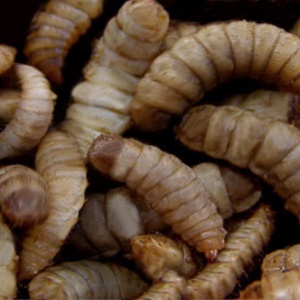
This paper provides an assessment of the environmental impacts of converting waste streams from the food industry into products such as fertiliser, pet food, livestock feed or feed additives using the larvae of Hermetia illucens, the black soldier fly.
The paper examines the production of Hermetia puree and Hermetia protein meal, with insect fertiliser and Hermetia fat being co-products of the process. Data on the pilot process were taken from a Protix plant in the Netherlands. During the process, Hermetia larvae are fed on waste streams from producing beer or other alcohol. The larvae are then killed and processed into fresh puree, lipids or dried insect meal.
Since the process creates several co-products, the life cycle assessment uses more than one functional unit. These are:
- 1 kg of dried and pelletised organic fertiliser (according to the Protix website, fertiliser is produced from food fibres, insect skins and droppings)
- 1 kg of fresh insect biomass (puree) used as a component for pet food production
- 1 kg of protein concentrated meal used as feed ingredient (and potentially for food)
- 1 kg of insect fat used as feed additive for pork production
The figure below shows the estimated environmental impacts of Hermetia puree (HP) and Hermetia protein meal (HM) in comparison to other protein sources, on a dry matter basis for each protein source. Long-term (LT), medium-term (MT) and short-term (ST) impacts are displayed separately for Hermetia products.

Image: Figure 3, Smetana et al. Environmental impacts of different sources of proteins (dry matter basis) weighted against HM, GWP – global warming potential; OD – ozone depletion; AC – acidification; EU – eutrophication; ED – energy demand; FD – freshwater depletion; LU – land use, relative impacts are censored at -100% and 250% to maintain the readability of the plot and as triangles at these limiting values.
The authors conclude that animal-based source of protein (e.g. chicken) generally have higher environmental impacts than Hermetia products, while plant-based sources of protein generally have lower impacts than Hermetia products, although in the long term Hermetia products could be environmentally competitive with plant proteins across several impact categories.
The paper also provides a consequential life cycle assessment, which accounts for shifts in market demand for different products. The authors note that switching from composting or anaerobically digesting industrial waste streams to feeding them to Hermetia illucens could result in lower environmental impacts.
Abstract
The lack of protein sources in several parts of the world is triggering the search for locally produced and sustainable alternatives. Insect production is recognized as a potential solution. This study is a life cycle assessment (LCA) of food industry side streams transformation via Hermetia illucens into intermediate products applicable for feed and food purposes. It relies on attributional modelling for the estimation of the most impacting stages of insect production and on consequential modelling for the estimation of potential benefits or risks for the agri-food system. The consequential LCA included effects on the market, associated with upstream increase in feed (increase in commercial feed production) or downstream availability of insect product (substitution of fertilizer, protein concentrate for feed or chicken meat). Attributional and consequential LCAs are followed by sensitivity analyses, which identify the most promising directions towards sustainable insect production and estimate the magnitude of impact reductions if those directions are pursued by the industry. Analyses of the existing pilot process largely correspond with other findings in the literature, indicating fresh insect biomass is almost twice more sustainable than fresh chicken meat. Produced at pilot scale, protein concentrate (insect meal) while being competitive against animal-derived (whey, egg protein, fishmeal) and microalgae, has higher environmental impacts than plant-based meals. Further scenarios illustrate strategies for more sustainable use of environmental resources providing guidance for producers and funding agencies to direct the industry to an impact profile that is lower, than many existing protein sources.
Reference
Smetana, S., Schmitt, E. and Mathys, A., 2019. Sustainable use of Hermetia illucens insect biomass for feed and food: Attributional and consequential life cycle assessment. Resources, Conservation and Recycling, 144, pp.285-296.
Read the full paper here. See also the Foodsource resource The value and limitations of lifecycle assessment.







Post a new comment »